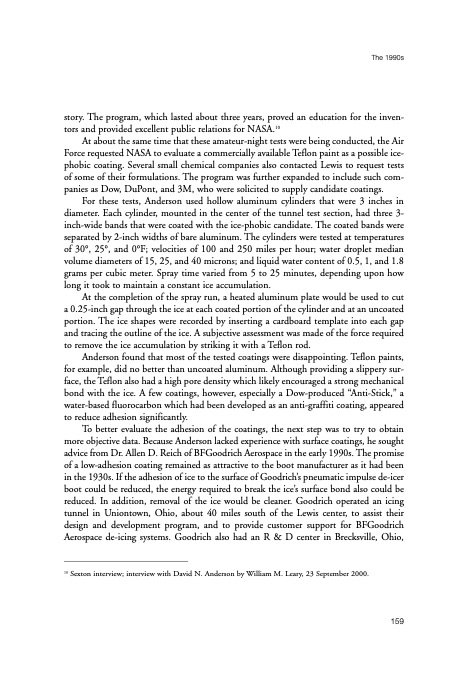
PDF Publication Title:
Text from PDF Page: 170
story. The program, which lasted about three years, proved an education for the inven- tors and provided excellent public relations for NASA.10 At about the same time that these amateur-night tests were being conducted, the Air Force requested NASA to evaluate a commercially available Teflon paint as a possible ice- phobic coating. Several small chemical companies also contacted Lewis to request tests of some of their formulations. The program was further expanded to include such com- panies as Dow, DuPont, and 3M, who were solicited to supply candidate coatings. For these tests, Anderson used hollow aluminum cylinders that were 3 inches in diameter. Each cylinder, mounted in the center of the tunnel test section, had three 3- inch-wide bands that were coated with the ice-phobic candidate. The coated bands were separated by 2-inch widths of bare aluminum. The cylinders were tested at temperatures of 30°, 25°, and 0°F; velocities of 100 and 250 miles per hour; water droplet median volume diameters of 15, 25, and 40 microns; and liquid water content of 0.5, 1, and 1.8 grams per cubic meter. Spray time varied from 5 to 25 minutes, depending upon how long it took to maintain a constant ice accumulation. At the completion of the spray run, a heated aluminum plate would be used to cut a 0.25-inch gap through the ice at each coated portion of the cylinder and at an uncoated portion. The ice shapes were recorded by inserting a cardboard template into each gap and tracing the outline of the ice. A subjective assessment was made of the force required to remove the ice accumulation by striking it with a Teflon rod. Anderson found that most of the tested coatings were disappointing. Teflon paints, for example, did no better than uncoated aluminum. Although providing a slippery sur- face, the Teflon also had a high pore density which likely encouraged a strong mechanical bond with the ice. A few coatings, however, especially a Dow-produced “Anti-Stick,” a water-based fluorocarbon which had been developed as an anti-graffiti coating, appeared to reduce adhesion significantly. To better evaluate the adhesion of the coatings, the next step was to try to obtain more objective data. Because Anderson lacked experience with surface coatings, he sought advice from Dr. Allen D. Reich of BFGoodrich Aerospace in the early 1990s. The promise of a low-adhesion coating remained as attractive to the boot manufacturer as it had been in the 1930s. If the adhesion of ice to the surface of Goodrich’s pneumatic impulse de-icer boot could be reduced, the energy required to break the ice’s surface bond also could be reduced. In addition, removal of the ice would be cleaner. Goodrich operated an icing tunnel in Uniontown, Ohio, about 40 miles south of the Lewis center, to assist their design and development program, and to provide customer support for BFGoodrich Aerospace de-icing systems. Goodrich also had an R & D center in Brecksville, Ohio, The 1990s 10 Sexton interview; interview with David N. Anderson by William M. Leary, 23 September 2000. 159PDF Image | History of NASA Icing Research Tunnel

PDF Search Title:
History of NASA Icing Research TunnelOriginal File Name Searched:
sp4226.pdfDIY PDF Search: Google It | Yahoo | Bing
NFT (Non Fungible Token): Buy our tech, design, development or system NFT and become part of our tech NFT network... More Info
IT XR Project Redstone NFT Available for Sale: NFT for high tech turbine design with one part 3D printed counter-rotating energy turbine. Be part of the future with this NFT. Can be bought and sold but only one design NFT exists. Royalties go to the developer (Infinity) to keep enhancing design and applications... More Info
Infinity Turbine IT XR Project Redstone Design: NFT for sale... NFT for high tech turbine design with one part 3D printed counter-rotating energy turbine. Includes all rights to this turbine design, including license for Fluid Handling Block I and II for the turbine assembly and housing. The NFT includes the blueprints (cad/cam), revenue streams, and all future development of the IT XR Project Redstone... More Info
Infinity Turbine ROT Radial Outflow Turbine 24 Design and Worldwide Rights: NFT for sale... NFT for the ROT 24 energy turbine. Be part of the future with this NFT. This design can be bought and sold but only one design NFT exists. You may manufacture the unit, or get the revenues from its sale from Infinity Turbine. Royalties go to the developer (Infinity) to keep enhancing design and applications... More Info
Infinity Supercritical CO2 10 Liter Extractor Design and Worldwide Rights: The Infinity Supercritical 10L CO2 extractor is for botanical oil extraction, which is rich in terpenes and can produce shelf ready full spectrum oil. With over 5 years of development, this industry leader mature extractor machine has been sold since 2015 and is part of many profitable businesses. The process can also be used for electrowinning, e-waste recycling, and lithium battery recycling, gold mining electronic wastes, precious metals. CO2 can also be used in a reverse fuel cell with nafion to make a gas-to-liquids fuel, such as methanol, ethanol and butanol or ethylene. Supercritical CO2 has also been used for treating nafion to make it more effective catalyst. This NFT is for the purchase of worldwide rights which includes the design. More Info
NFT (Non Fungible Token): Buy our tech, design, development or system NFT and become part of our tech NFT network... More Info
Infinity Turbine Products: Special for this month, any plans are $10,000 for complete Cad/Cam blueprints. License is for one build. Try before you buy a production license. May pay by Bitcoin or other Crypto. Products Page... More Info
| CONTACT TEL: 608-238-6001 Email: greg@infinityturbine.com | RSS | AMP |